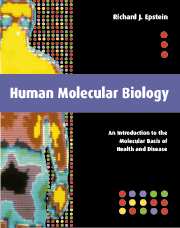Book contents
- Frontmatter
- Contents
- Preface
- Acknowledgements
- Read me first …
- Glossary
- Dedication
- Introduction: A disease for every gene?
- I From molecular biology to human genetics
- 1 Biomolecular evolution
- 2 Chromatin and chromosomes
- 3 Gene expression
- 4 RNA processing and translation
- 5 Protein structure and function
- II From molecular genetics to human biochemistry
- III From molecular biochemistry to human cell biology
- IV From molecular cell biology to human physiology
- V From molecular physiology to human molecular biology
- Index
3 - Gene expression
Published online by Cambridge University Press: 01 June 2011
- Frontmatter
- Contents
- Preface
- Acknowledgements
- Read me first …
- Glossary
- Dedication
- Introduction: A disease for every gene?
- I From molecular biology to human genetics
- 1 Biomolecular evolution
- 2 Chromatin and chromosomes
- 3 Gene expression
- 4 RNA processing and translation
- 5 Protein structure and function
- II From molecular genetics to human biochemistry
- III From molecular biochemistry to human cell biology
- IV From molecular cell biology to human physiology
- V From molecular physiology to human molecular biology
- Index
Summary
The genetic code
Nucleic and amino acids share a structure–function continuum
The genetic code has traditionally been regarded as an arbitrary encryption device for polypeptide synthesis. This creates a problem for origin-of-life theories: a pure encryption device should require preformed molecular machinery for interpreting and implementing the code, and would thus not exist in prebiotic environments. In fact, amino and nucleic acids exhibit significant structural and functional correspondences that seem likely to have been relevant to the evolution of primordial biomolecules.
With respect to the function of encoded amino acids, the most important codon component is the second base and the least critical the third, with the first occupying an intermediate position. The physical properties of amino acids are linked to the nucleotide sequence of codons: if the second nucleotide is A the encoded residue is hydrophilic (tending to sit on the outside of proteins), whereas if the second nucleotide is U/T, it is hydrophobic (tending to embed itself within the protein core). The survival of simple microorganisms such as bacteria depends more on the rapid mutability of their genomes rather than on conservation of functions: the strain will survive provided at least one organism resistant to environmental threats is available at any one time. Conversely, highly evolved multicellular organisms such as humans require stricter genomic conservation to maintain function.
These diverging paradigms of genetic evolution may be designated neutralist (primarily driven by random mutation) or selectionist (primarily driven by functional conservation).
- Type
- Chapter
- Information
- Human Molecular BiologyAn Introduction to the Molecular Basis of Health and Disease, pp. 77 - 95Publisher: Cambridge University PressPrint publication year: 2002



